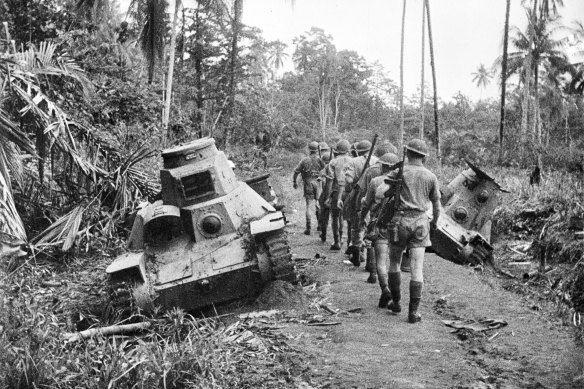

A group of Australian soldiers inspecting two disabled Type 95 Ha-Go Japanese light tanks. Late August, 1942.
Japanese naval prestige has suffered another blow by the week’s events at Milne Bay. It has been established that the fight was an essentially naval affair, and that a Japanese naval landing force made the landings. Unlike Japanese forces fighting at Kokoda, who are well equipped and wearing Australian made army boots, the Japanese defeated at Milne Bay were poorly equipped.
The Japanese force used most of the tricks of jungle warfare which their army has exploited. An Australian patrol leader reports that when his patrol came upon a heap of Japanese dead a man leapt from the heap and fired. Australians are now making sure that the Japanese dead are “safely” dead.
Milne Bay marks one of the most serious Japanese blunders of the war. It was the first time the Japanese have sent a boy to do a man’s job.
First published in The Age on September 15, 1942
Loading
WOUNDED FROM MILNE BAY
Praise Land and Air Co-operation
SOMEWHERE IN AUSTRALIA
Straight from Milne Bay and fighting around Kokoda, the first wounded have arrived at an Australian port. They are full of praise for air support and that given by the Australian artillery at Milne Bay. The consensus of opinion was that without Australian 25-pounders and air bombing and strafing, Milne Bay might have been a different story.
Arthur Mackin, of East Brisbane, who previously had been through the Libyan campaign, and was at Tobruk, said they had never seen such perfect co-operation between land and air forces as that achieved by our men at Milne Bay. They were cheerful despite their wounds.
Most of the returned men looked remarkably fit. They hail from all over Australia—from Cairns to Ballarat and Bendigo, from the northern tablelands of New South Wales to West Australia. “We thought we would never see the sun again,” said one of the men, Bill Gavin, of Brisbane, who limped ashore with a shrapnel wound in the knee. Fighting at Milne Bay was a strange experience for men who already had seen action in Libya and Syria.
Loading
“The Japanese certainly outwitted us in the jungle,” admitted Mervyn Watley, of Maryborough, “but we feel certain we would be able to beat them in open fighting,” he added. “As soon as the Australians became accustomed to Japanese noise tactics they were able to handle them.” His unit had first met the invaders at 3 a.m. on the first morning of landing near Gilli Gilli, and by afternoon they had driven the Japanese back over a mile. Great difficulty was experienced in handling the Japanese owing to their practice of laying up in day time and coming out only at night.
Noel Schnabel, of Bundaberg, described the Japanese noise tactics as much like commotion at a football match when a try was scored. “They set up a clatter and chatter, blew trumpets and whistles and let off crackers. Many of the crackers appeared to have been released from a kind of delayed action grounds, which were thrown behind the lines and set up a racket, that caused us to think at first we had been surrounded.”
“How the Japanese can talk English!” said Schnabel. ″We would be on patrol, and a voice in the clearest Australian would greet you with ‘Hey Bill, is the corporal there?’ Some of our boys fell for it for a while. They lifted their heads, and were shot to pieces. After that we were awake to the trick.”









 Add Category
Add Category